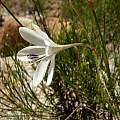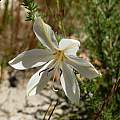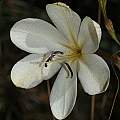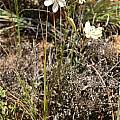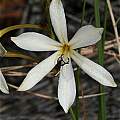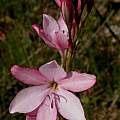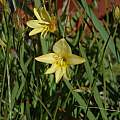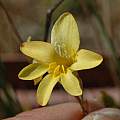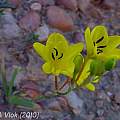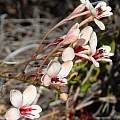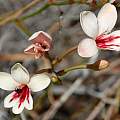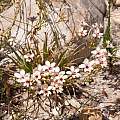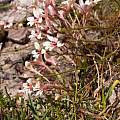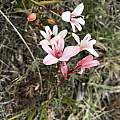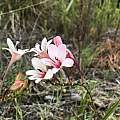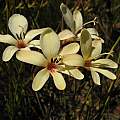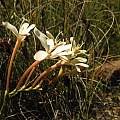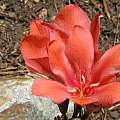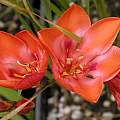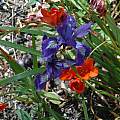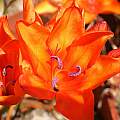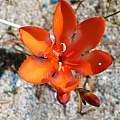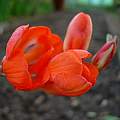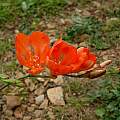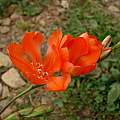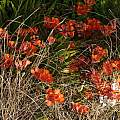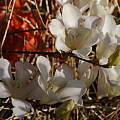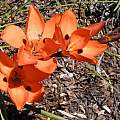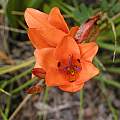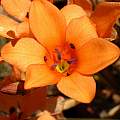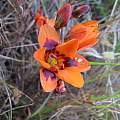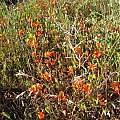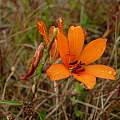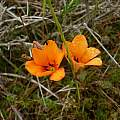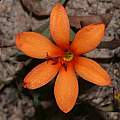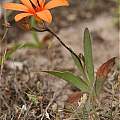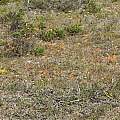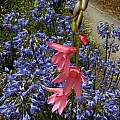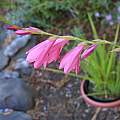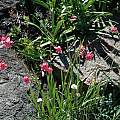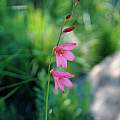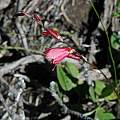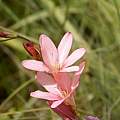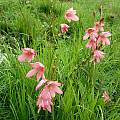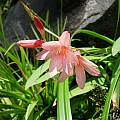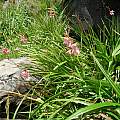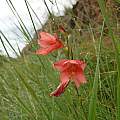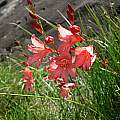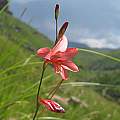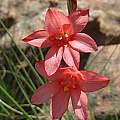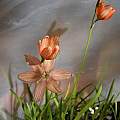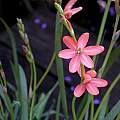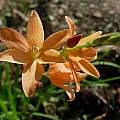Tritonia is a cormous genus in the Iridaceae family from southern Africa. Most of them are in the winter rainfall regions or areas with some rain year round, but there are summer rainfall species too. They occur in a variety of habitats: grassland in summer rainfall areas, renosterveld, karroid scrub, and fynbos in winter rainfall areas. Tritonia species a-d are found on this page.
Tritonia bakeri Klatt grows on rocky sandstone slopes from the Little Karoo to the southeastern Cape. Plants are up to 60 cm tall and flowers are almost regular, cream to creamy yellow or mauvish pink with a long slender tube with dark brown veining on the outer side and purple stamens. It flowers October-December.
Tritonia bakeri ssp. bakeri has flowers that are 65-90 mm long and creamy to creamy yellow. The first two photos were taken by Cameron McMaster at Potjiesberg Pass in the Little Karoo. The other photos were taken by Andrew Harvie. Photos 3-4 were taken in the southeastern Cape. Photos 5-6 of a thin-petaled form were taken on the N9 between Montagu Pass and Outeniqua Pass.
Tritonia bakeri ssp. lilacina (L.Bolus) M.P.de Vos has mauvish pink, sometimes cream flowers with a somewhat shorter tube (35-50 mm long). Photo from the book Plants of the Klein Karoo courtesy of Jan and Anne Lise Schutte-Vlok.
Tritonia chrysantha Fourc. grows on dry karroid slopes mostly in the southern part of the Eastern Cape. It flowers August to October and grows to 40 cm tall, but is usually much smaller. Leaves are broad and flowers are long-tubed and bright yellow with a yellow callus on the lower tepals, often on a small pinkish red blotch. The first two photos were taken by Bob Rutemoeller of Alan Horstmann’s plants. The third photo from the book Plants of the Klein Karoo courtesy of Jan and Anne Lise Schutte-Vlok.
Tritonia cooperi (Baker) Klatt grows on rocky sandstone soils in the Southwestern Cape. It has bilaterally symmetrical long tubed white to cream flowers fading to pink with red or purple markings, growing up to 60 cm tall. It flowers November to December. The first six photos from iNaturalist were taken by Charles Stirton, carinalochner and Derek Silberblatt in November and shared under a CC BY-NC license.
Photos from iNaturalist taken by Nick Helme on the Cape Peninsula in November and December and shared under a CC BY-SA license.
There are two subspecies that differ mainly in leaf width and habitat. Tritonia cooperi ssp. cooperi has 4-grooved leaves that are x-shaped in cross section and 1-6 mm in diameter more or less as long as the scape and is found on stony hills, ridges and mountain slopes. Tritonia cooperi ssp. quadrialata M.P.de Vos has leaves with 4 longitudinal flanges that are h-shaped in cross section and 6-10 mm wide reaching up to the base of the spike and sometimes higher and occurs mainly in mesophytic habitats.
Tritonia crispa (L.f.) Ker Gawl. is now known as Tritonia undulata.
Tritonia crocata (L.) Ker Gawl. is one of the most commonly grown species and one that has been hybridized as well. It has orange to reddish flowers, but without prominent veins. Height: 25-50 cm. It blooms in late spring. It grows on stony clay slopes in the renosterveld in the southern Cape. The first three photos by Bob Rutemoeller and Mary Sue Ittner of California grown plants including a nice companion planting in the garden with Iris douglasiana. The last two photos were taken by Alan Horstmann.
The photos below were taken by Cameron McMaster in the Overberg.
Tritonia crocata has naturalized in the California garden of Michael Mace, where it grows at the base of a Japanese maple tree in part shade. The bulbs grow in a layer of mulch on top of the clay subsoil, and are dry in summer. The dead leaves are from Moraea aristata, which has also naturalized in the same spot. The second photo shows a white form that cropped up in the patch.
Tritonia deusta (Aiton) Ker Gawl., a plant with orange flowers with a yellow star-shaped center and sometimes dark marks on the other tepals, is found on clay or granite slopes in renosterveld and grows in the southwest and southern Capes. Height: 15-25 cm.
Tritonia deusta ssp. deusta has outer segments with a reddish black blotch or stripe with a dark raised ridge or callus. There are sometimes smaller blotches on one or more inner segments. The first two photos were taken by Bob Rutemoeller and Mary Sue Ittner of plants grown from seed in California. The third picture was taken by Alan Horstmann. The fourth photo was taken by Rod Saunders.
Photos from Cameron McMaster were taken in the Overberg.
Tritonia deusta ssp. miniata (Jacq.) M.P.de Vos does not have dark blotches or stripes on the outer segments. Other segments sometimes have a yellow and often red-margined blotch, small dark spot, or median line in the throat. Photos by Andrew Harvie taken in the De Hoop Nature Reserve.
Tritonia disticha (Klatt) Baker is found on mountain slopes in grassland and rock outcrops in the southeastern Cape (summer rainfall area) to KwaZulu-Natal. It has sword shaped leaves with a raised midrib and a vein near the margins, bright red, orange, yellow or pink flowers with a yellow blotch on the 3 lower lobes and blooms summer into early fall. Height: to about 1 m. The first photograph by Bob Rutemoeller shows one blooming in the Mendocino Coast Botanical Gardens August 2004 combined nicely with a clump of Agapanthus. The second photo by Mary Sue Ittner illustrates the droopy character of the ones she grows blooming September 2004.
Photos by 1-3 from Bob Rutemoeller and Mary Sue Ittner taken January 2010 at Gaika's Kop.
Photos below were taken by Cameron McMaster in the Eastern Cape.
Tritonia drakensbergensis M.P.de Vos is found on the southern parts of the Drakensberg range in the northern Eastern Cape. It flowers January to March. It has long narrow rigid leaves and red or pinkish scarlet flowers with the tube about half the length of the segments and with low yellow almost triangular shaped calli. Height range: 20-30 cm. Photos by Cameron McMaster taken in the Eastern Cape.
Tritonia dubia Eckl. ex Klatt has pink to orange flowers with dark veins spirally arranged in dense spikes. It is found on clay slopes in renosterveld and open bush in the southeastern Cape and blooms in early spring. Height: 12-25 cm. Grown from Silverhill Seed listed as Ixia pumillo, it is now correctly identified. The second picture showed plants blooming the next year. This species is the first to bloom for me, often blooming in March months before the other species. Photos by Mary Sue Ittner and Cameron McMaster.
